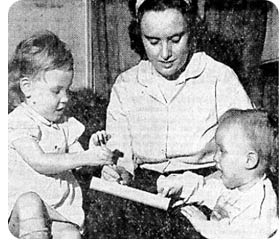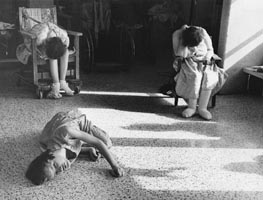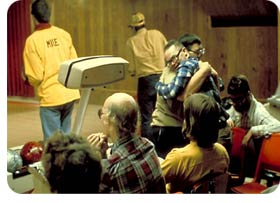1960s: Building the Momentum
Rolvaag Asks Legislature for More, Legislature Counters with Less
In 1965, Governor Rolvaag raised the question, "Who was not willing to pay another $5 to $10 in taxes to put someone on the road to rehabilitation and a fuller life?"
Rolvaag asked the Legislature for more staff, compulsory PKU testing and an additional $500,000 to develop more day programs.
The Legislature countered with 100 fewer positions and $50,000 less for day programs.

In 1965, Governor Rolvaag asked the Legislature to fund mandatory PKU testing.
An August 1964 study showed that half of the state's more than 6,350 residents were assigned jobs in institutions, raising the issue of "institutional peonage."
Institutional peonage is work, servitude or slavery in exchange for protection.
By law, a person with mental retardation could earn no more than $1 a month. Replacing institutionalized residents with civil service employees would require more than 900 additional positions at a cost of $2.4 million.

Residents of state institutions worked at a variety of jobs for a mere $1 a month, raising concerns about institutional peonage.
Exposés of Institutional Conditions
Public awareness continued to play a key role in initiating change. Reporting for the Minneapolis Tribune, Sam Newlund wrote exposés of institutional conditions on January 10, 1965 and April 16, 1967.
Conditions were deplorable, he reported. Children became teens and then adults, all while their disheartening circumstances remained the same.

Conditions were deplorable,
according to a Minneapolis Tribune exposé.
STAR TRIBUNE/MINNEAPOLIS-ST. PAUL 2009.

Video: Sam Newlund, Star Tribune reporter, who covered state social service activities and with photographer Earl Sieffert did an impactful story on hospital conditions.
Part 1: Unannounced Visit and the Exposé of Faribault State Hospital
Part 2: Comparing Kansas and Minnesota Conditions
Part 3: A Reporter’s First Hand Account
The Regionalization Movement
In response, the Department of Public Welfare initiated the Cambridge Moose Lake Project and began transferring people with developmental disabilities from Cambridge to Moose Lake, a traditional community mental health hospital.
Originally prompted by overcrowding, the regionalization movement had begun.
By regionalizing services, people with developmental disabilities could be cared for closer to their homes. Hospitals started serving multiple groups and school districts began paying for school programs within the institutions.

The Cambridge Moose Lake Project marked the start of the regionalization movement.

Poster Child of the Year and Muriel Humphrey,
Arc's National Chair in 1965.
In 1965, Minnesotan Dickie Bach of Columbia Heights was selected Arc's national "poster child of the year."
The national campaign, chaired by Muriel Humphrey, used the slogan "Give as if he were your own" to generate giving.

Bowling played an important role
in improving quality of life.
In 1966, Brainerd State Hospital created an experimental day camp. The hospital also constructed two bowling alleys for residents.
No one could have predicted the popularity bowling would have in such settings, nor its dominance in improving quality of life for people with developmental disabilities.

An innovative Day Program at Cambridge began in 1966
In 1966, the Cambridge hospital opened a day program for 73 young girls.
To address the peonage issue, residents of all state hospitals could apply to become civil service workers and skip the required exams.







